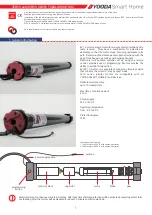
56
Technical description
Cooling system
These engines are fluid-cooled and have a closed circuit cooling system. The system has two circuits. In the
inner circuit (the freshwater system), coolant is pumped around by a centrifugal-type coolant pump (circulation
pump). In the TAMD63, TAMD73 and TAMD74, this pump is driven by the vibration damper via a belt. On the
TAMD71 engines, the coolant pump is gear driven via the timing gears.
From the coolant pump, the coolant is pumped out into a distribution channel in the cylinder block and con-
veyed around the cylinder liners and on up through the cylinder heads.
From each cylinder head and from the turbocharger’s turbine housing, the coolant is fed back to the thermostat
housing, where a thermostat regulates its temperature. Coolant from the engine’s oil cooler is also fed to the
thermostat housing.
While the coolant is cold, the thermostat shuts off the flow to the heat exchanger. The coolant then passes
through a by-pass line beneath the thermostat and directly back to the pump’s suction side. When the coolant
temperature has risen to a certain value, the thermostat opens and allows coolant to pass to the heat exchang-
er and the by-pass line closes.
In the heat exchanger, heat from the coolant is transferred to the seawater before the coolant is sucked back
into the coolant pump.
Large amounts of heat are also removed by the lubricating oil, which channels off the heat to the freshwater
system via the oil cooler. The lubricating oil is also used to dissipate heat from the pistons in the engine (see
“Pistons” on page 43).
The cooling system may operate with a small amount of overpressure. The risk of boiling is thereby reduced if
the temperature is high. If the pressure is higher than normal, a pressure valve in the filler cap opens.
The flow in the seawater system is maintained by a gear-wheel driven impeller (blade-type) pump which is
located at the front of the engine. The seawater passes through the engine’s charge air cooler (CAC)* and heat
exchanger and the reverse gear’s oil cooler. A zinc anode is fitted in the reverse gear’s oil cooler as protection
against galvanic corrosion. The TAMD63, TAMD73 and TAMD74 also has a zinc anode in the heat exchanger
and the charge air cooler (CAC).
It is important to check the condition of the zinc anode(s) according to the maintenance schedule to prevent
corrosion damage.
The engine may have a separate expansion tank as an accessory.
* Note. In the TAMD71 the seawater passes the heat exchangers before being fed to the charge air coolers and the reverse gear’s
oil cooler.
Flow through heat exchangers and charge air coolers (CAC) in the TAMD71
= Charge air or freshwater
= Seawater
5
4
3
7
8
9
10
1
6
2
1. Seawater inlet
2. Seawater pump
3. Freshwater from
engine’s thermostat
housing
4. Heat exchangers
5. Charge air coolers
(CAC)
6. Seawater outlet
7. Oil cooler, reverse
gear
8. Charge air from
turbocharger
9. Cooled charge air to
the engine intake
manifold
10. Freshwater to the
engine coolant pump,
suction side
7740156 - Downloaded from www.volvopenta.com 22/07/2009 00:44:08
Summary of Contents for TAMD63L
Page 1: ...INSTRUCTION BOOK TAMD63L P TAMD71B TAMD73P WJ TAMD74C L P ...
Page 2: ...7740156 Downloaded from www volvopenta com 22 07 2009 00 44 08 ...
Page 120: ...118 Notes 7740156 Downloaded from www volvopenta com 22 07 2009 00 44 08 ...
Page 121: ...119 Notes 7740156 Downloaded from www volvopenta com 22 07 2009 00 44 08 ...
Page 123: ...7740156 Downloaded from www volvopenta com 22 07 2009 00 44 08 ...
Page 124: ...7740156 0 English 6 2000 AB Volvo Penta SE 405 08 Göteborg Sweden www volvopenta com ...
















































